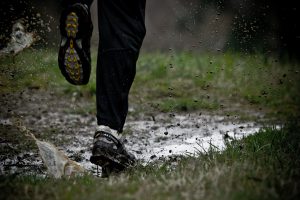Submitted by Thurston County Public Health & Social Services
Though in winter months we have a lot of wet, and in some years very cold, weather here in the south Puget Sound area, it’s generally mild in and around Thurston County. That means getting outside to be active, whether walking or rolling (bicycling, in-line skating or other activity), and boosting our health in the process, is something most people here can do year-round. Wintertime does pose some particular challenges to staying safe, due to the shorter daylight hours and inclement conditions, so here are some tips to help you stay safe while you are striving for that healthy activity.
Challenge: Less daylight
-

Outdoor activity during the winter months requires special attention to safety. Photo courtesy: Hood Canal Events. Wear light-colored clothes. Trying to fit activity into the limited daylight hours of winter can be tough. It’s warmer during the day, but we spend many of our hours from 8:00 a.m. to 5:00 p.m. at work. If you are doing outdoor activities such as bicycling, running or walking at dusk or in the evening, night or early morning hours, try to make yourself highly visible to others around you, especially people in motor vehicles.
- Use a flashlight or other active lighting, and have reflective material on yourself or your backpack, purse or other bag you carry. A front light and red rear reflector are required for bicycling after dusk or before dawn. You’ll be safer if you do more than the minimum (for example, making sure that you can be seen from the sides using reflectors). If you have companions on your walk – a child, a pet, a stroller – make sure that they are well lit and visible as well.
- Cross streets at well-lit places, preferably where there are good markings and warning signals.
It’s safest to act as if you can’t be seen, particularly around dusk or when it’s dark, so only cross in front of vehicles when you know they are stopped (or better yet wait until all traffic has cleared the roadway you are crossing).
Challenge: Cold Weather
Hypothermia, when our bodies get so chilled they start to shut down, can happen especially in rainy cold conditions. Try to keep your body from getting cold by layering your clothing, and wearing an outer, waterproof yet breathable or vented, layer to keep you mostly dry. Try to get warm and dry again as soon as possible after your outdoor exercise. And bring a hat – we lose a lot of our body’s heat through our heads.
Prevent Falls

On those days and nights when the temperatures hover around or go below freezing, usually November through February, be cautious when you’re out on sidewalks, streets or trails. A slip and fall on hard surfaces can cause injuries that go beyond inconvenience and pain. Check the air temperatures before you go out and test the traction you have when you start. Sometimes it’s best to wait for a thaw (which is often only a rainshower away) or to be sure that your paths on your route(s) have been de-iced.
Buddy Up
They say there’s safety in numbers – you’ll be more visible as a group and there’s the personal security benefit. And it definitely helps to have walking partners to encourage us.
Be Active
Getting that 30 minutes a day as an adult (or 150 minutes or more in your week) can be quite easy: find 10 minutes at a time (a break at work, a grocery errand, walking with a friend you’ve been meaning catch up with, or taking active transportation to get a child to school). Or for a longer stretch, do that sport or other intense activity you enjoy.
Just take a few precautions to do it safely and you’ll be on your way to better health and the many other benefits of walking and regular physical activity.
Find more information on activity options at the health department webpage.





















































